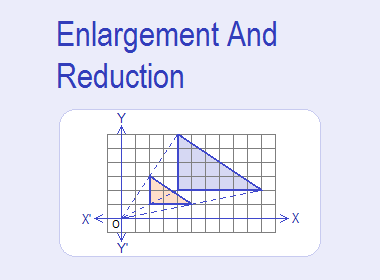
Enlargement (or reduction) is a transformation
in which the size of an object is changed without changing its original shape. If the size
of the object increase, we call it an enlargement and if the size of an object
decrease, we call it a reduction.
********************
10 Math Problems officially announces the release of Quick Math Solver and 10 Math Problems, Apps on Google Play Store for students around the world.
********************
********************
The enlargement is made with the help of a fixed point called centre of enlargement and by the fixed ratio called scale factor i.e. the ratio of the corresponding sides of the image and object.
As enlargement changes the size
of the object, it will have no real sense in case of a point.
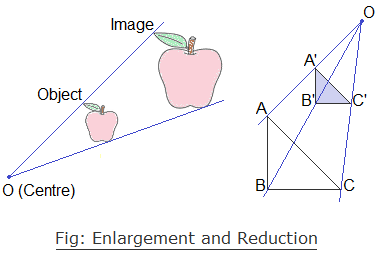
The following are the properties of enlargement:
1.
The object and the image
under the enlargement are similar.
2. Scale factor (k) =

3.
If the scale factor k>1,
then the transformation is called enlargement.
4.
If the scale factor
0<k<1, then the transformation is called reduction.
5.
If the scale factor k=1,
then the transformation is identity.
6.
If the scale factor k<0,
then the image will be on the opposite side of the object from the centre of
enlargement.
Example 1: Find the image of ΔABC under the enlargement with the centre of
enlargement O and scale factor 2. [It is denoted by E(O, 2)]
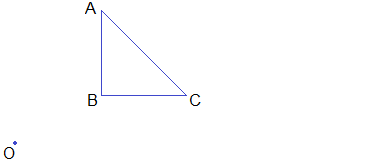
Solution:
For the image ΔABC under the given enlargement, perform the
following steps:
Step 1: Join OA, OB and OC.
Step 2: Produce OA upto A’ such that OA’ = 2OA.
Step 3: Produce OB upto B’ such that OB’ = 2OB.
Step 4: Produce OC upto C’ such that OC’ = 2OC.
Step 5: Join A’B’, B’C’ and C’A’.
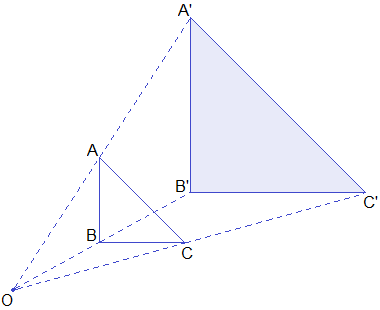
Hence, ΔA’B’C’ is the required image of ΔABC under the enlargement E(O, 2).
Example 2: Find the image of ΔPQR under the enlargement with centre of enlargement O and scale factor -½.

Solution:
As the scale factor is negative i.e. - ½, the image of ΔABC will be on the opposite side of centre O and the size will be half of the given figure. i.e. image of each side will be half of its corresponding object side.
Step 1: Join OP, OQ and OR.
Step 2: Produce PO upto P’ such that OP’ = ½OP.
Step 3: Produce QP and RO upto Q’ and R’ in the same direction so that
OQ’ = ½ OQ and OR’ = ½OR.
Step 4: Join P’Q’, Q’R’ and R’P’.
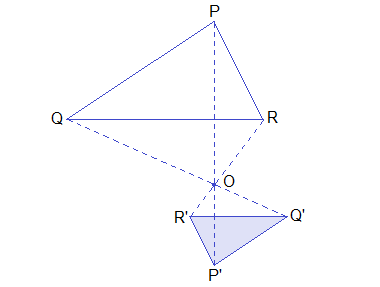
Hence, ΔP’Q’R’ is the image of ΔPQR under the given enlargement.
Enlargement Using Co-ordinates
The image under the enlargement with a given centre
of enlargement and scale factor can be obtained with the help of co-ordinates.
Enlargement With Centre At Origin And Scale Factor k.
Let P(3, 1) and Q(2, 4) be two points and k = 2 be the scale factor and O(0, 0) be the centre of enlargement. Join OP and OQ and produce OP upto P’ such that OP’ = 2OP and produce OQ upto Q’ such that OQ’ = 2OQ and join P’Q’ which is the image of PQ.
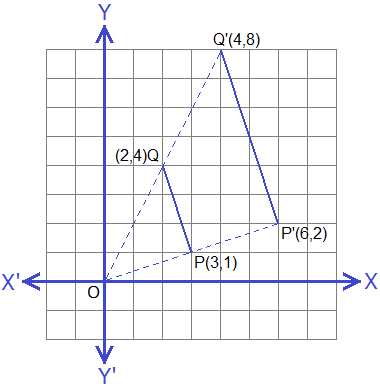
The co-ordinates of P’ and Q’ are
(6, 2) and (4, 8) respectively.

Let us see the following table of some points in the plane and their corresponding images under the enlargement with centre O(0, 0) and scale factor k.

From the following table, we can see that the image of any point P(x, y) under the enlargement with centre O(0, 0) and scale factor k is P’(kx, ky),

Example 3: If a square ABCD with vertices A(1, 2), B(1, 1), C(2, 1) and D(2, 2)
is enlarged with the centre of enlargement O(0, 0) and scale factor 4. Find the co-ordinates of the
vertices of the image square ABCD and draw ABCD and its image on the same graph
paper.
Solution:
As the square ABCD has vertices A(1, 2), B(1, 1), C(2, 1) and D(2, 2), the image of these vertices under the enlargement with centre O(0, 0) and scale factor 4 can be obtained by using the formula,

Hence, the co-ordinates of image square A’B’C’D’ are A’(4, 8),
B’(4, 4), C’(8, 4) and D’(8, 8). Drawing square ABCD and square A’B’C’D’ on the
same graph paper we get the figure as shown:

Enlargement With Centre At Any Point M(a, b) And Scale Factor k.
The image of point P(x, y) under the enlargement
with centre at any point M(a, b) and scale factor k can be derived by the following
procedure.
Step 1: Draw a new co-ordinate
axes X1MX1’ and Y1MY1’ having
origin at M(a, b) and parallel to original axes.
Step 2: Find the co-ordinates of
P(x, y) according to new co-ordinates axes i.e. P1’(x-a, y-b).
Step 3: Find the image of P(x-a,
y-b) under the enlargement with centre M(a, b) (origin of new axes) and scale
factor k, which is P1’[k(x-a), k(y-b)],

Step 4: Change the co-ordinates of image P’ to the original co-ordinate axes.
i.e. P’[k(x-a), k(y-b)]
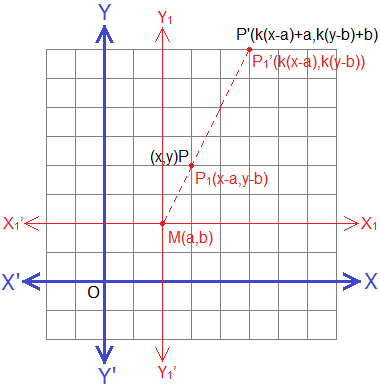
Hence, the image of P(x, y) under the enlargement
with centre M(a, b) and scale factor k is given by P’[k(x-a)+a, k(y-b)+b], i.e.

Example 4: If ΔPQR with vertices P(-1, 2), Q(-1, -1) and R(1, 0) is enlarged
with centre of enlargement M(1, 1) and scale factor -2. Find the co-ordinates
of vertices of the image ΔPQR and draw ΔPQR and its image on the same graph
paper.
Solution:
As P(-1, 2), Q(-1, -1) and R(1, 0) are the vertices of ΔPQR, the
image of these vertices under the enlargement with centre M(1, 1) and scale
factor -2 by using formula,

The vertices of image ΔP’Q’R’ under the given enlargement are
P’(5, -1), Q’(5, 5) and R’(1, 3). Drawing ΔPQR and ΔP’Q’R’ on the same graph
paper, we have the below figure.

Example 5: If A(-1, -1), B(0, -3) and C(2, 0) are the vertices of ΔABC and
ΔA’B’C’ is the image of ΔABC under the enlargement where A’(0, 2), B’(2, -2)
and C’(6, 4). Find the centre and scale factor of this enlargement.
Solution:
As we have the co-ordinates of ΔABC and its image ΔA’B’C’ under
the enlargement, we can find the centre and the scale factor of enlargement by
drawing.
Step 1: Draw ΔABC and ΔA’B’C’ with the help of the given co-ordinates.
Step 2: Join AA’ and BB’ (or CC’) and produce them to meet each other
at M.
Step 3: Co-ordinates of centre M is (-2, -4) and scale factor

Hence, the required centre of enlargement is (-2, -4) and scale
factor k = 2.
Alternative Method:
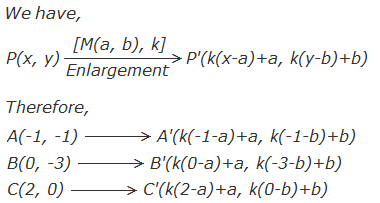
But, the vertices of image A’B’C’ are A’(0, 2), B’(2, 2) and
C’(6, 4)
So, k(-1-a)+a = 0 ……………
(i)
k(0-a)+a = 2 …………….
(ii)
k(2-a)+a = 6 …………….
(iii)
and, k(-1-b)+b = 2 …………..
(iv)
k(-3-b)+b = 2 …………..
(v)
k(0-b)+b = 4 ……………
(vi)
Subtracting (i) from (ii), we get
K = 2
Putting the value of k = 2 in (i)
2(-1-a)+a = 0
or, -2-2a+a = 0
or, a = -2
Putting the value of k in (iv)
2(-1-b)+b = 2
or, -2-2b+b = 2
or, b = -4
Hence, the centre of enlargement is (-2, -4) and scale factor 2.
If you have
any questions or problems you can ask in the comments section below.
Was this article helpful? LIKE and SHARE it with friends…
Related Articles:



triangle pqr having the vertices p(3, 4) q(2, 1) and r(4, 2) is translated by t = [[- 2] [3]] the image so formed is enlarged by e[(0, 0), 2] . writing the coordinates of the vertices of images thus obtained, represent the triangle pqr and its images in the same graph paper.
ReplyDeleteThis comment has been removed by the author.
ReplyDelete